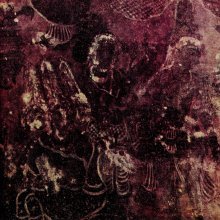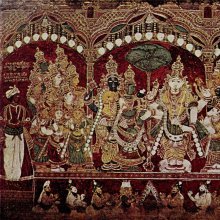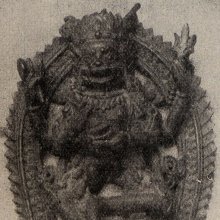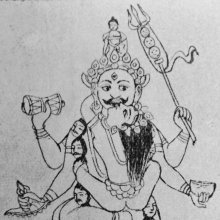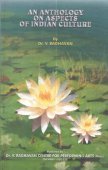Sundara, Shundara, Śuṇḍāra, Sumdara: 29 definitions
Introduction:
Sundara means something in Buddhism, Pali, Hinduism, Sanskrit, Jainism, Prakrit, the history of ancient India, Marathi, biology. If you want to know the exact meaning, history, etymology or English translation of this term then check out the descriptions on this page. Add your comment or reference to a book if you want to contribute to this summary article.
The Sanskrit term Śuṇḍāra can be transliterated into English as Sundara or Shundara, using the IAST transliteration scheme (?).
Images (photo gallery)
In Hinduism
Purana and Itihasa (epic history)
Source: archive.org: Puranic Encyclopedia1) Sundara (सुन्दर).—A Gandharva, the son of Vīrabāhu. Due to Vasiṣṭha’s curse he was born as a Rākṣasa whom Mahāviṣṇu later on raised from his fallen state. (Skanda Purāṇa).
2) Sundara (सुन्दर).—An Āndhra monarch, son of Pulindasena and father of King Śātakarṇi. (Viṣṇu Purāṇa, Part 4).
Source: archive.org: Shiva Purana - English TranslationSundara (सुन्दर) is the name of a Gaṇeśvara (attendant of Śiva), according to the Śivapurāṇa 2.5.9 (“Śiva’s campaign”).—Accordingly, as Śiva with the Gods attacked Tripura: “[...] O great Brahmins, all the Gaṇeśvaras went to the three cities. Who can enumerate them fully? I shall mention a few. These were the important ones who were there—[e.g., Sundara] [...]. These and other innumerable lords of Gaṇas who cannot be characterised and classified surrounded Śiva and went ahead. [...] They were capable of burning the entire world including the mobile and immobile beings, within a trice by their very thought. Surrounding Śiva, the great lord, they went ahead. [...]”.
Source: Cologne Digital Sanskrit Dictionaries: The Purana Index1a) Sundara (सुन्दर).—Śāntikarṇa, ruled for a year.*
- * Matsya-purāṇa 273. 11.
1b) A son of Pulindasena and father of Śatakarṇi.*
- * Viṣṇu-purāṇa IV. 24. 47.

The Purana (पुराण, purāṇas) refers to Sanskrit literature preserving ancient India’s vast cultural history, including historical legends, religious ceremonies, various arts and sciences. The eighteen mahapuranas total over 400,000 shlokas (metrical couplets) and date to at least several centuries BCE.
Chandas (prosody, study of Sanskrit metres)
Source: Shodhganga: a concise history of Sanskrit Chanda literatureSundara (सुन्दर) is the alternative name of a Sanskrit metre (chandas) mentioned by Hemacandra (1088-1173 C.E.) in his auto-commentary on the second chapter of the Chandonuśāsana. Sundara corresponds to Maṇibhūṣaṇa, Ramaṇīya. Hemacandra gives these alternative names for the metres by other authorities (like Bharata), even though the number of gaṇas or letters do not differ.

Chandas (छन्दस्) refers to Sanskrit prosody and represents one of the six Vedangas (auxiliary disciplines belonging to the study of the Vedas). The science of prosody (chandas-shastra) focusses on the study of the poetic meters such as the commonly known twenty-six metres mentioned by Pingalas.
Ayurveda (science of life)
Source: archive.org: Vagbhata’s Ashtanga Hridaya Samhita (first 5 chapters)Sundarā (सुन्दरा) or Sarvāṅgasundarī by Aruṇadatta is the name of a commentary on the Aṣṭāṅgahṛdayasaṃhitā: one of the three great works of Vāgbhaṭa.—The Aṣṭāṅgahṛdayasaṃhitā consists only of verses. The eight-fold division is observed in the Aṣṭāṅgahṛdayasaṃhitā too, though not as strictly as in the Aṣṭāṅgasaṃgraha. Numerous commentaries on the Aṣṭāṅgahṛdayasaṃhitā [viz., the Sundarā], many of them unedited so far, can be traced in manuscripts, catalogues, publishers’ lists, etc.

Āyurveda (आयुर्वेद, ayurveda) is a branch of Indian science dealing with medicine, herbalism, taxology, anatomy, surgery, alchemy and related topics. Traditional practice of Āyurveda in ancient India dates back to at least the first millenium BC. Literature is commonly written in Sanskrit using various poetic metres.
Shaktism (Shakta philosophy)
Source: Google Books: Manthanabhairavatantram1) Sundara (सुन्दर) refers to one of the eight Heroes (vīra-aṣṭaka) associated with Tisrapīṭha (located in the ‘end of sound’—nādānta), according to the Manthānabhairavatantra, a vast sprawling work that belongs to a corpus of Tantric texts concerned with the worship of the goddess Kubjikā.—[...] The eight Heroes (vīrāṣṭaka): Ṭaṅkadhārīśa, Koṭīśa, Sundara, Śaśāṅkin, Kṛtavāsa, Vasanta, Saṃtoṣa, Kusumāyudha
2) Sundara (अमर) refers to the Vaṭuka associated with Candra, one of the eight Sacred Seats (pīṭha), according to the Yogakhaṇḍa (chapter 14) of the Manthānabhairavatantra.
3) Sundara (अमर) or Khagagāmin also refers to the Vaṭuka associated with Nāda, another one of the eight Sacred Seats (pīṭha).

Shakta (शाक्त, śākta) or Shaktism (śāktism) represents a tradition of Hinduism where the Goddess (Devi) is revered and worshipped. Shakta literature includes a range of scriptures, including various Agamas and Tantras, although its roots may be traced back to the Vedas.
In Buddhism
Theravada (major branch of Buddhism)
Source: Pali Kanon: Pali Proper Names1. Sundara. A city where Kassapa Buddha performed the Yamaka patihariya at the foot of an asana tree (BuA.218), and Konagamana Buddha under a mahasala tree (BuA.214).
2. Sundara. A monk of Rajagaha. One day, as he walked through the street, a woman asked him to stop for a moment that she might worship him, and, raising the end of his robe, took his penis into her mouth. A doubt arose in his mind as to whether any blame attached to him and he consulted the Buddha, who said that as Sundara had not acquiesced in the act, he was blameless. Vin.iii.36; of the story of St. Anthony.
3. Sundara. A monk who, with five hundred others of the same name, was present at the Foundation Ceremony of the Maha Thupa. MT.522.
Theravāda is a major branch of Buddhism having the the Pali canon (tipitaka) as their canonical literature, which includes the vinaya-pitaka (monastic rules), the sutta-pitaka (Buddhist sermons) and the abhidhamma-pitaka (philosophy and psychology).
Tibetan Buddhism (Vajrayana or tantric Buddhism)
Source: archive.org: The Indian Buddhist IconographySundarā (सुन्दरा) is one of the twenty-four Goddesses surrounding Buddhakapāla in the buddhakapālamaṇḍala, according to the 5th-century Sādhanamālā (a collection of sādhana texts that contain detailed instructions for rituals).—Buddhakapāla refers to one of the various emanations of Akṣobhya and the sādhana says that when Heruka is embraced by Citrasenā he gets the name of Buddhakapāla.—Sundarā in the eastern gate-guardian. She has a blue colour two arms, one face, ornaments of bones, brown hair rising upwards but no garlands of heads. She carries the kapāla in the left and the kartri in the right, and dances in the ardhaparyaṅka attitude.
Source: academia.edu: The Structure and Meanings of the Heruka MaṇḍalaSundara (सुन्दर) is the name of a Vīra (hero) who, together with the Ḍākinī named Sundarī forms one of the 36 pairs situated in the Jñānacakra, according to the 10th century Ḍākārṇava chapter 15. Accordingly, the jñānacakra refers to one of the three divisions of the saṃbhoga-puṭa (‘enjoyment layer’), situated in the Herukamaṇḍala. The 36 pairs of Ḍākinīs and Vīras [viz., Sundara] are white in color; the shapes of their faces are in accordance with their names; they have four arms; they hold a skull bowl, a skull staff, a small drum, and a knife.
Source: OSU Press: Cakrasamvara SamadhiSundara (सुन्दर) refers to “beautiful (divine power)”, according to the Cakrasaṃvara Samādhi [i.e., Cakrasamvara Meditation] ritual often performed in combination with the Cakrasaṃvara Samādhi, which refers to the primary pūjā and sādhanā practice of Newah Mahāyāna-Vajrayāna Buddhists in Nepal.—Accordingly, “The letter E shape, abode of strong essence, the womb space of the lotus, Therein the midst, a secret Vaṃ, a beautiful bowl, the origin of all one’s self, An abode of perfectly pure awakened omniscience, beautiful divine power (devyālaya-sundara), And I, innately pure, praise the highest pleasure, the innate heroic couple”.

Tibetan Buddhism includes schools such as Nyingma, Kadampa, Kagyu and Gelug. Their primary canon of literature is divided in two broad categories: The Kangyur, which consists of Buddha’s words, and the Tengyur, which includes commentaries from various sources. Esotericism and tantra techniques (vajrayāna) are collected indepently.
In Jainism
General definition (in Jainism)
Source: archive.org: Een Kritische Studie Van Svayambhūdeva’s PaümacariuSundara (सुन्दर) participated in the war between Rāma and Rāvaṇa, on the side of the latter, as mentioned in Svayambhūdeva’s Paumacariu (Padmacarita, Paumacariya or Rāmāyaṇapurāṇa) chapter 57ff. Svayambhū or Svayambhūdeva (8th or 9th century) was a Jain householder who probably lived in Karnataka. His work recounts the popular Rāma story as known from the older work Rāmāyaṇa (written by Vālmīki). Various chapters [mentioning Sundara] are dedicated to the humongous battle whose armies (known as akṣauhiṇīs) consisted of millions of soldiers, horses and elephants, etc.

Jainism is an Indian religion of Dharma whose doctrine revolves around harmlessness (ahimsa) towards every living being. The two major branches (Digambara and Svetambara) of Jainism stimulate self-control (or, shramana, ‘self-reliance’) and spiritual development through a path of peace for the soul to progess to the ultimate goal.
India history and geography
Source: Shodhganga: Ajanta’s antiquitySundara (r. 76-77 CE) or Sundara Śātakarṇi is a king from the Sātavāhana dynasty of ancient India. The Sātavāhana lineage (known as Andhra in the Purāṇas) once ruled much of the Deccan region and several of the Ajantā caves at West-Khandesh (West-Khaṇḍeśa, modern Jalgaon) were carved in the 3rd century BCE when the region was ruled by kings (e.g., Sundara Śātakarṇi ) and descendants of the Sātavāhana kings. Sundara Śātakarṇi was preceded by Purindraṣeṇa and succeeded by Chakora Śātakarṇi.

The history of India traces the identification of countries, villages, towns and other regions of India, as well as mythology, zoology, royal dynasties, rulers, tribes, local festivities and traditions and regional languages. Ancient India enjoyed religious freedom and encourages the path of Dharma, a concept common to Buddhism, Hinduism, and Jainism.
Biology (plants and animals)
Source: Google Books: CRC World Dictionary (Regional names)Sundara in India is the name of a plant defined with Anisomeles malabarica in various botanical sources. This page contains potential references in Ayurveda, modern medicine, and other folk traditions or local practices It has the synonym Craniotome mauritianum (Pers.) Bojer (among others).
Example references for further research on medicinal uses or toxicity (see latin names for full list):
· Prodromus Stirpium in Horto ad Chapel Allerton vigentium (1796)
· Proceedings of the Indian Science Congress Association (1979)
· Glimpses in Plant Research (1998)
· Proceedings of the Indian Academy of Sciences (1985)
· Journal of Cytology and Genetics (1982)
· International Journal of Cancer Research (2007)
If you are looking for specific details regarding Sundara, for example chemical composition, extract dosage, health benefits, pregnancy safety, side effects, diet and recipes, have a look at these references.

This sections includes definitions from the five kingdoms of living things: Animals, Plants, Fungi, Protists and Monera. It will include both the official binomial nomenclature (scientific names usually in Latin) as well as regional spellings and variants.
Languages of India and abroad
Pali-English dictionary
Source: BuddhaSasana: Concise Pali-English Dictionarysundara : (adj.) good; nice; beautiful.
Source: Sutta: The Pali Text Society's Pali-English DictionarySundara, (adj.) (cp. Epic & Class. Sk. sundara) beautiful, good, nice, well J. II, 11, 98; SnA 410, 493 (cp. parovara). It is very frequent as Commentary word, e.g. for prefix su° PvA. 57, 77; VvA. 111; for subha PvA. 14, 44; for sādhu SnA 176; for sobhana PvA. 49; for seyyo PvA. 130. (Page 719)

Pali is the language of the Tipiṭaka, which is the sacred canon of Theravāda Buddhism and contains much of the Buddha’s speech. Closeley related to Sanskrit, both languages are used interchangeably between religions.
Marathi-English dictionary
Source: DDSA: The Molesworth Marathi and English Dictionarysundara (सुंदर).—a (S) Handsome or beautiful. 2 Used freely, as are the English words Capital, superb, splendid, fine &c., to express admiration or approbation of the object.
--- OR ---
sundarā (सुंदरा).—f (Used in poetry for sundarī) A beautiful woman.
Source: DDSA: The Aryabhusan school dictionary, Marathi-Englishsundara (सुंदर).—a Handsome; capital, superb.
--- OR ---
sundarā (सुंदरा) [-rī, -री].—f A beautiful woman.
Marathi is an Indo-European language having over 70 million native speakers people in (predominantly) Maharashtra India. Marathi, like many other Indo-Aryan languages, evolved from early forms of Prakrit, which itself is a subset of Sanskrit, one of the most ancient languages of the world.
Sanskrit dictionary
Source: DDSA: The practical Sanskrit-English dictionaryŚuṇḍāra (शुण्डार).—
1) A distiller.
2) An elephant's trunk or proboscis; शुण्डारः कलभेन यद्वदचले वत्सेन दोर्दण्डकः (śuṇḍāraḥ kalabhena yadvadacale vatsena dordaṇḍakaḥ) Mv.1.53.
Derivable forms: śuṇḍāraḥ (शुण्डारः).
--- OR ---
Sundara (सुन्दर).—a. (-rī f.) (sund-araḥ Uṇādi-sūtra 3.133)
1) Lovely, beautiful, handsome, charming.
2) Right.
-raḥ Name of Cupid.
-rī A beautiful woman; एका भार्या सुन्दरी वा दरी वा (ekā bhāryā sundarī vā darī vā) Bhartṛhari 2.115; विद्याधरसुन्दरीणाम् (vidyādharasundarīṇām) Kumārasambhava 1.7.
Source: Cologne Digital Sanskrit Dictionaries: Edgerton Buddhist Hybrid Sanskrit DictionarySundara (सुन्दर).—(1) name of a king: Mahāvastu i.249.16; 252.5; (2) name of a prince (also °raka): Avadāna-śataka i.189.10; 190.1 (both prose); (3) name of a householder's son: Avadāna-śataka ii.201.13 ff.; (4) name of a nāga: Mahāvyutpatti 3312; (5) name of a yakṣa: Mahā-Māyūrī 43.
--- OR ---
Sundarā (सुन्दरा).—name of a female doorkeeper (dvārapālinī): Sādhanamālā 502.14.
Source: Cologne Digital Sanskrit Dictionaries: Shabda-Sagara Sanskrit-English DictionaryŚuṇḍāra (शुण्डार).—m.
(-raḥ) 1. A distiller, a vintner. 2. An elephant’s proboscis. E. śuṇḍā spirits, ra aff.
--- OR ---
Sundara (सुन्दर).—mfn.
(-raḥ-rā or -rī-raṃ) Handsome, beautiful. m.
(-raḥ) Kamadeva. f. (-rī) 1. A handsome woman. 2. A small timber tree, (Heritiera minor.) 3. Turmeric. 4. A species of metre. E. su good, excellent, dṛ to respect, aff. ap; or su with undi to moisten, aff. aran .
Source: Cologne Digital Sanskrit Dictionaries: Benfey Sanskrit-English DictionaryŚuṇḍāra (शुण्डार).— (cf. śuṇḍa), m. 1. A distiller. 2. An elephant’s trunk, Mahāvīrac. 17, 7.
--- OR ---
Sundara (सुन्दर).—I. adj., f. rī, Handsome, [Pañcatantra] 184, 14; [Draupadīpramātha] 1, 15; charming, [Kathāsaritsāgara, (ed. Brockhaus.)] 22, 103; right, [Pañcatantra] 130, 4; 164, 11. Comparat. ºratara + m, adv. Very well, [Pañcatantra] 88, 15. Ii. m. Kāma, the god of love. Iii. f. rī. 1. A bandsome woman, [Rāmāyaṇa] 3, 52, 29. 2. Turmeric. 3. A small timber tree, Heritiera minor.
Source: Cologne Digital Sanskrit Dictionaries: Cappeller Sanskrit-English DictionaryŚuṇḍāra (शुण्डार).—[masculine] the trunk of a young elephant.
--- OR ---
Sundara (सुन्दर).—[feminine] ī beautiful, fair; [masculine] a man’s name; [feminine] ī a (fair) woman.
Source: Cologne Digital Sanskrit Dictionaries: Aufrecht Catalogus Catalogorum1) Sundara (सुन्दर) as mentioned in Aufrecht’s Catalogus Catalogorum:—Vārāṇasīdarpana kāvya.
2) Sundara (सुन्दर):—son of Rāghava: Vārāṇasīdarpaṇa.
Source: Cologne Digital Sanskrit Dictionaries: Monier-Williams Sanskrit-English Dictionary1) Śuṇḍāra (शुण्डार):—[from śuṇḍ] m. the trunk of a young elephant, [Mahāvīra-caritra]
2) [v.s. ...] an elephant 60 years old, [Demetrius Galanos’s Lexiko: sanskritikes, anglikes, hellenikes]
3) [v.s. ...] a distiller or seller of spirituous liquor, [cf. Lexicographers, esp. such as amarasiṃha, halāyudha, hemacandra, etc.]
4) Sundara (सुन्दर):—[from sund] mf(ī)n. (perhaps for su-nara = sūnara; d being inserted as in [Greek] ἀνδρός [from] ἀνήρ) beautiful, handsome, lovely, charming, agreeable, [Mahābhārata; Kāvya literature] etc.
5) [v.s. ...] noble, [Subhāṣitāvali]
6) [from sund] m. Clerodendron Phlomoides, [cf. Lexicographers, esp. such as amarasiṃha, halāyudha, hemacandra, etc.]
7) [v.s. ...] a palace of a [particular] form, [cf. Lexicographers, esp. such as amarasiṃha, halāyudha, hemacandra, etc.]
8) [v.s. ...] Name of Kāma-deva, [cf. Lexicographers, esp. such as amarasiṃha, halāyudha, hemacandra, etc.]
9) [v.s. ...] of a serpent-demon, [Buddhist literature]
10) [v.s. ...] of a son of Pravilasena, [Viṣṇu-purāṇa]
11) [v.s. ...] of various authors (also with ācārya, kavi, bhaṭṭa etc.), [Catalogue(s)]
12) [from sund] n. = -kāṇḍa below.
Source: Cologne Digital Sanskrit Dictionaries: Yates Sanskrit-English Dictionary1) Śuṇḍāra (शुण्डार):—(raḥ) 1. m. A distiller.
2) Sundara (सुन्दर):—[su-ndara] (raḥ-rā-rī-raṃ) a. Handsome, beautiful. m. Kāma. f. (ī) A beauty; timber tree; turmeric.
Source: DDSA: Paia-sadda-mahannavo; a comprehensive Prakrit Hindi dictionary (S)Sundara (सुन्दर) in the Sanskrit language is related to the Prakrit word: Suṃdara.
[Sanskrit to German]
Sanskrit, also spelled संस्कृतम् (saṃskṛtam), is an ancient language of India commonly seen as the grandmother of the Indo-European language family (even English!). Closely allied with Prakrit and Pali, Sanskrit is more exhaustive in both grammar and terms and has the most extensive collection of literature in the world, greatly surpassing its sister-languages Greek and Latin.
Prakrit-English dictionary
Source: DDSA: Paia-sadda-mahannavo; a comprehensive Prakrit Hindi dictionarySuṃdara (सुंदर) in the Prakrit language is related to the Sanskrit word: Sundara.
Prakrit is an ancient language closely associated with both Pali and Sanskrit. Jain literature is often composed in this language or sub-dialects, such as the Agamas and their commentaries which are written in Ardhamagadhi and Maharashtri Prakrit. The earliest extant texts can be dated to as early as the 4th century BCE although core portions might be older.
Kannada-English dictionary
Source: Alar: Kannada-English corpusSuṃdara (ಸುಂದರ):—[adjective] very pleasing to the eye, ear, mind, etc.; attractive; lovely; beautiful.
--- OR ---
Suṃdara (ಸುಂದರ):—
1) [noun] the quality of a thing, person, etc. that pleases or satisfies the senses or mind; beauty; attractiveness; charm; grace.
2) [noun] that which is beautiful; a beautiful thing.
3) [noun] a handsome man.
4) [noun] the tree Clerodendrum phlomidis of Verbenaceae family.
5) [noun] its beautiful flower.
6) [noun] (pros.) a metrical verse having four lines, each of which having four groups of three syllables each followed by one short and a long syllable (-uu, -uu, -u-, uu-, u, -).
Kannada is a Dravidian language (as opposed to the Indo-European language family) mainly spoken in the southwestern region of India.
See also (Relevant definitions)
Starts with (+46): Cuntarakkatavul, Cuntaramurtinayanar, Cuntarar, Sumdaramga, Sumdaramgi, Sumdarate, Sumdaravesha, Sumdaravritta, Sundara acarya, Sundara aujjagari, Sundara bhatta, Sundara kavi, Sundara shukla, Sundara-badanika, Sundarabahustava, Sundarabahustotra, Sundarabja, Sundaradasa, Sundaradava, Sundaradeva.
Ends with (+54): Amarasundara, Aparadhasundara, Asundara, Atisundara, Bhuvanasundara, Brahmandasundara, Chandahsundara, Chhandahsundara, Chirasundara, Cirasundara, Devasundara, Gaganasundara, Girishasundara, Grishmasundara, Gunasundara, Hayanasundara, Hiranyasundara, Ishanasundara, Jayasundara, Jinasundara.
Full-text (+231): Asundara, Sundar, Sundaraka, Sundaram, Sundarata, Atisundara, Aujagari, Sundaravati, Pakshasundara, Saundarya, Aujjagari, Haci, Anangamangala, Sundarakanda, Grishmasundaraka, Sumdaravritta, Sumdara, Sumdarate, Sundarataram, Sundararajiya.
Relevant text
Search found 80 books and stories containing Sundara, Sundarā, Shundara, Śuṇḍāra, Su-ndara, Sumdara, Suṃdara; (plurals include: Sundaras, Sundarās, Shundaras, Śuṇḍāras, ndaras, Sumdaras, Suṃdaras). You can also click to the full overview containing English textual excerpts. Below are direct links for the most relevant articles:
Garga Samhita (English) (by Danavir Goswami)
Verse 5.20.37 < [Chapter 20 - The Liberation of Ṛbhu Muni During the Rāsa-dance Festival]
Verse 4.2.14 < [Chapter 2 - The Story of the Gopīs That Had Been Sages]
Verse 2.10.2 < [Chapter 10 - Description of Śrī Kṛṣṇa’s Herding the Cows]
Brihad Bhagavatamrita (commentary) (by Śrī Śrīmad Bhaktivedānta Nārāyana Gosvāmī Mahārāja)
Verse 2.1.91 < [Chapter 1 - Vairāgya (renunciation)]
Verse 2.4.39 < [Chapter 4 - Vaikuṇṭha (the spiritual world)]
Verse 2.4.64-65 < [Chapter 4 - Vaikuṇṭha (the spiritual world)]
Sahitya-kaumudi by Baladeva Vidyabhushana (by Gaurapada Dāsa)
Text 10.256 < [Chapter 10 - Ornaments of Meaning]
Text 10.1 [Upamā] < [Chapter 10 - Ornaments of Meaning]
Text 10.226 < [Chapter 10 - Ornaments of Meaning]
Bhajana-Rahasya (by Srila Bhaktivinoda Thakura Mahasaya)
Text 14 < [Chapter 8 - Aṣṭama-yāma-sādhana (Rātri-līlā–prema-bhajana sambhoga)]
Text 8 < [Chapter 3 - Tṛtīya-yāma-sādhana (Pūrvāhna-kālīya-bhajana–niṣṭhā-bhajana)]
Text 4 < [Chapter 5 - Pañcama-yāma-sādhana (Aparāhna-kālīya-bhajana–kṛṣṇa-āsakti)]
The Indian Buddhist Iconography (by Benoytosh Bhattachacharyya)
Tirumal Rao's Premonition < [July – September 1977]
The Husband < [April – June, 1990]
Two Poems < [October 1958]
Related products
